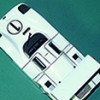The view that the late twenties and early thirties were
not the nadir of Grand Prix racing was first aired by Paul Sheldon in Volume 2 of his "Black Book" series in 1990, I believe, and even as a young student of motor racing it struck me as ahistorical at the time. Sheldon "streamlined" his version of events by elevating all Formula Libre events to Grand Prix status from 1928 onwards, to neatly fit into the 1931 scenario when all engineering requirements for Grand Prix cars were to be abandoned, and "true" Grands Prix distinguished themselves from other races merely by the duration of the event or, later, the distance to be run.
Looking back, it can be argued that this era represented merely a transitional period to "modern" aspects of Grand Prix racing, but at the time it was the very heart and soul, the
raison d'etre of the Grand Prix that appeared to be at stake. Only two decades before, the event was born expressly as a contest between manufacturers, or constructors if you will, to supersede the failed experiment of a contest between nations, represented by the Gordon-Bennett races, as the pinnacle event of the then new sport. As such, it had waxed and waned over the years, often in accordance with the varying "exercises" (or challenges) presented by the technical rules of the International Formula. But to abandone this purpose in 1931 meant the total collapse, not of the sport, but of the idea of the Grand Prix!
Quite interestingly, this development was ultimately fore-shadowed by the events in the USofA about a decade before, when more and more manufacturers left the sport for various reasons, until only three (very small) companies were left: Duesenberg, Frontenac and Miller - how easy is it to find parallels to Alfa Romeo, Bugatti and Maserati here!! Economics soon dictated that these companies built their cars to sell, right off the factory floor instead of after usage as works cars; the birth of the production racing car, in effect. Grand Prix racing (and Indianapolis) survived, eventually, but as a completely different animal.
About private entries, Roger has already explained the Zborowski/Miller situation. Halford and Eldridge weren't "privateers", of course, they were constructors/manufactureres.
Edited by Michael Ferner, 19 July 2015 - 15:23.

















